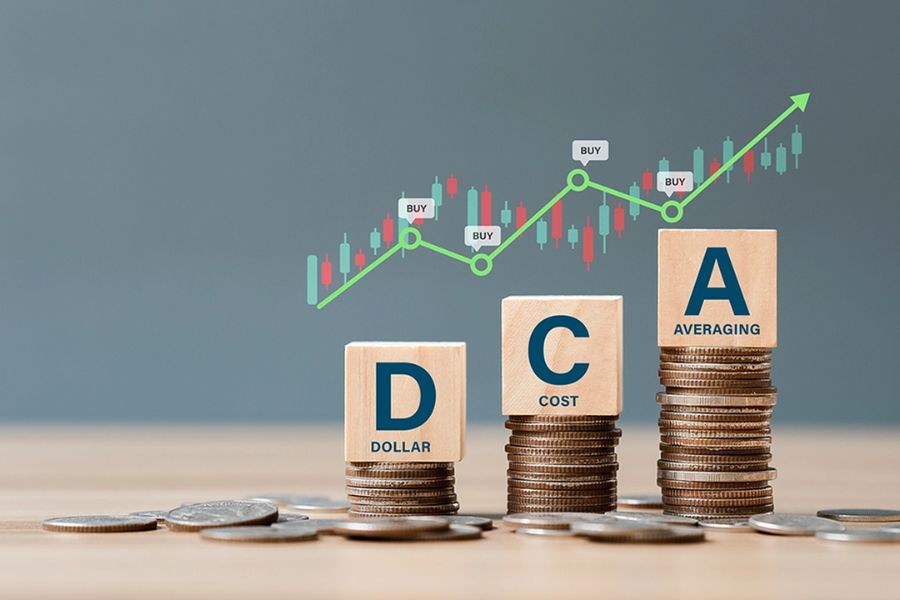Most people believe you need a large sum to start investments. I found out that small monthly investments of just $10 can actually outperform a single $1,000 investment over time. This happens because of dollar-cost averaging and consistent market participation. It’s not about getting rich quick—it’s about letting time and consistency work their magic.

When I first heard about this, I felt skeptical. How could $10 a month possibly beat dropping $1,000 at once? The answer surprised me. Regular contributions harness the power of compound interest and help smooth out market ups and downs.
Let’s break down how this works, using real examples and simple calculations. You’ll see why starting with just $10 monthly can lead to better results than waiting to invest a lump sum.
Key Takeaways
- Monthly $10 investments often outperform $1,000 lump sums thanks to dollar-cost averaging and more time in the market.
- Compound interest works best with consistent contributions over longer periods.
- Starting small and investing regularly beats waiting to save up larger amounts.
The Power of Monthly Investments Versus Lump Sums
Monthly investing and lump sum investing build wealth in different ways. Timing, risk management, and your mindset play big roles in both approaches.
1. Consistency and Timing
The biggest difference is when you put money into the market. With monthly investing, I spread my money across many months or years. Lump sum investing means placing all your money in at once. Your principal gets immediate exposure to the market.Monthly investing creates a consistent habit. I invest the same amount every month, no matter what’s happening.
You don’t need to worry about picking the “perfect” time to invest. The habit of monthly investing makes it easier to stick with your plan. Most people don’t have $1,000 sitting around, but finding $10 each month feels doable.
2. Dollar-Cost Averaging and Risk Reduction
Dollar-cost averaging is just a fancy way to describe monthly investing. It means buying more shares when prices are low and fewer when prices are high. When the market drops, my $10 buys more shares. When the market rises, my $10 buys fewer shares. This approach helps smooth out the ups and downs. I don’t end up buying everything at the peak.

Benefits of Dollar-Cost Averaging:
- Protects against market volatility by balancing out good and bad months.
- Reduces stress about timing the market.
- Averages out the price per share over time.
While lump sum investing can sometimes win in a steadily rising market, dollar-cost averaging shines when markets are bumpy or uncertain. The real win? Peace of mind and steady progress.
3. Start Small, Grow Big: Breaking Through Mental Barriers
The biggest hurdle isn’t money—it’s fear. Many people think they need hundreds or thousands to get started. Starting with $10 removes that mental barrier. It feels safe and manageable. I began my investment journey with small amounts, which helped me build confidence. Over time, those small steps added up.
Psychological Perks:
- Less stress and anxiety about investing.
- Easy to keep going, even when times get tough.
- Builds good money habits early.
- Grows your investment knowledge as you go.
Monthly investing also fights lifestyle inflation. Instead of spending that extra $10 on coffee, I put it toward my future.
After a few months, the habit becomes automatic. I hardly notice the money leaving my account.
This method teaches patience and long-term thinking—skills that matter more than picking the perfect stock or timing the market.
How Compound Interest Supercharges Small, Recurring Contributions
Compound interest turns small monthly investments into real wealth. You earn interest on both your original investment and the interest you’ve already earned.
The more often your money compounds, the faster it grows. Regular $10 contributions often outperform bigger one-time investments for this reason.
4. Compound Interest Made Simple
Compound interest means I earn money on my starting amount plus all the interest I’ve earned so far. Over time, this creates a snowball effect. For example, if I invest $100 at 8% interest, I earn $8 in the first year. In the second year, I earn interest on $108—not just the original $100.
Each $10 monthly addition gets its own compounding timeline. My January investment compounds for the whole year, while my December one compounds for just a month. Regular contributions mean new money starts compounding right away. I don’t wait to save up a large amount before investing.

Time is the most powerful factor in compounding. Starting small now beats waiting to start big later.
5. Compounding Frequency: Why It Matters
Compounding frequency tells you how often your interest gets added. The more often, the faster your money grows.
Here are the common options:
- Daily: Interest calculated 365 times a year.
- Monthly: 12 times a year.
- Quarterly: 4 times a year.
- Annually: Once a year.
A $10 monthly investment at 8% grows faster with daily compounding than with monthly or annual compounding. Most investment and savings accounts compound monthly or daily. Check this before deciding where to put your $10.
6. The Compound Interest Formula in Action
The formula for compound interest is: A = P(1 + r/n)^(nt)
- A = Final amount
- P = Principal (your starting money)
- r = Annual interest rate (as a decimal)
- n = Compounds per year
- t = Number of years
With monthly contributions, each payment has its own compounding timeline. Early contributions get more time to grow than later ones.
For example, if I invest $10 monthly at 8% with monthly compounding:
- Month 1: $10 compounds for 11 more months.
- Month 6: $10 compounds for 6 more months.
- Month 12: $10 compounds for the remainder of that year.
This staggered effect shows why starting early—even with small amounts—matters so much.
Comparing Growth: $10 Monthly vs $1000 Lump Sum with Real Examples
Let’s look at some real numbers. I used a 7% annual return, which matches typical long-term stock market performance.
7. Growth Calculations Side by Side
10-Year Comparison:
| Strategy | Total Invested | Final Value | Total Growth |
|---|---|---|---|
| $10 Monthly | $1,200 | $1,658 | $458 |
| $1000 Lump Sum | $1,000 | $1,967 | $967 |

The lump sum wins after 10 years, thanks to more time in the market.
20-Year Comparison:
| Strategy | Total Invested | Final Value | Total Growth |
|---|---|---|---|
| $10 Monthly | $2,400 | $5,240 | $2,840 |
| $1000 Lump Sum | $1,000 | $3,870 | $2,870 |
Now the monthly strategy starts to catch up.
30-Year Comparison:
| Strategy | Total Invested | Final Value | Total Growth |
|---|---|---|---|
| $10 Monthly | $3,600 | $10,143 | $6,543 |
| $1000 Lump Sum | $1,000 | $7,612 | $6,612 |
After 30 years, the monthly investor ends up with more money, even though the total growth percentages are similar.
8. Try Investment Calculators Yourself
I love using investment calculators to test different scenarios. You can adjust the return rate, time period, and monthly contribution to see what works best for you.

Look for these features:
- Monthly contribution options.
- Compounding frequency settings.
- Adjustable time horizons.
- Changeable return rates.
Try running your own numbers with $500, $1,000, or even $2,000. Mix lump sums with monthly contributions to see your personalized results. Calculators also let you experiment with different market return scenarios. Try 5%, 7%, and 10% returns to see the impact.
9. Time Horizons and Market Fluctuations
Time makes a huge difference. Longer periods favor monthly investing because of dollar-cost averaging. The lump sum approach depends a lot on timing. If you invest right before a downturn, your returns can take a hit.
Monthly investing spreads this risk. When markets drop, your $10 buys more shares. When markets rise, you benefit from shares bought at lower prices. During the 2008 crash, lump sum investors who put money in at the top saw big losses. Monthly investors bought at different prices, lowering their average cost.
Markets usually recover within a few years. Monthly investors keep buying during recoveries, capturing gains as prices bounce back. Market ups and downs hurt lump sum investing more. Monthly investing adapts automatically to changing conditions.
Best Investment Vehicles for Small Deposits
You can put your $10 monthly investments into several options. From stocks and ETFs to high-yield savings accounts, there are plenty of ways to grow small amounts.
10. Stocks, Mutual Funds, and ETFs
I suggest starting with exchange-traded funds (ETFs) for small deposits. They offer instant diversification, and many brokers now allow fractional share investing with no minimum.
S&P 500 index funds are my favorite for beginners. For example, the Schwab S&P 500 Index Fund charges just 0.02% annually and has a $1 minimum. Your $10 gets spread across 500 companies.
Individual stocks also work if you have $50 or $100 to invest each month. You can buy shares of solid companies like Coca-Cola or Walmart, which often pay dividends.

Mutual funds accept small amounts, but their fees can be higher. I prefer ETFs for their low costs and flexibility. Some mutual funds waive minimums if you set up automatic monthly investments.
Target-date funds are great for retirement. They adjust your investment mix as you age and often accept $25 to $50 monthly contributions.
11. High-Yield and Traditional Savings Accounts
High-yield savings accounts earn over 4% interest in 2025 while keeping your money safe. Online banks usually offer the best rates and don’t require a minimum balance.
FDIC insurance covers up to $250,000 per account. Savings accounts are perfect for emergency funds and short-term goals. Money market accounts pay higher interest and sometimes allow limited check writing. They may require higher minimums but offer strong rates.
Traditional bank savings accounts usually pay less than 1%. I skip these unless I need easy branch access. Certificates of deposit (CDs) lock up your money for a set time but guarantee higher returns. Six-month to two-year CDs work well for future expenses you know are coming.
Cash management accounts from brokers often pay competitive rates and combine banking with investing in one place.
Ready to start? Begin with just $10 a month. The most important thing is to get started and stay consistent. Over time, your small steps will add up to big results.
Real Estate and Alternative Assets
Real estate investment trusts (REITs) let me invest in property with small amounts. Many REIT ETFs trade for under $100 per share and pay steady dividends from rental income.
Fractional real estate platforms like Fundrise allow me to start with just $10. I own tiny pieces of commercial properties and collect quarterly distributions.

Returns usually range from 3-7% annually. It feels empowering to watch my small investments grow alongside large commercial projects.
Peer-to-peer lending platforms give me the chance to lend money to individuals or small businesses. I can start investing with as little as $25 per loan.
Returns can be 5-12%, but there’s always the risk that borrowers might default. I always remind myself to diversify and not put all my eggs in one basket.
Cryptocurrency lets anyone invest any amount, but the ride can be bumpy. I keep crypto to 5-10% of my portfolio to manage the wild price swings.
Commodity ETFs open the door to gold, oil, and agriculture. These funds trade like regular ETFs, so I don’t need a big minimum to get started.
They’re a great way to diversify beyond stocks and bonds. I’ve found that adding a little bit of commodities can help balance out my portfolio.
Frequently Asked Questions
Ever wonder if small monthly investments can compete with big lump sums? Let’s break it down with real-life examples and practical insights.
Can small monthly investments really outperform large one-time contributions?
Absolutely! Small monthly investments sometimes outperform lump sums, especially when markets are volatile or falling.
I’ve watched $10 monthly investments over 10 years beat a single $1,200 investment made at the wrong time. Market timing and volatility make a big difference.
Monthly investing works best when prices move up and down. You buy more shares when prices are low and fewer when they’re high.
What are the benefits of dollar-cost averaging in investment strategies?
Dollar-cost averaging takes the stress out of trying to time the market. I invest the same amount each month, rain or shine.
This strategy lowers my average cost per share over time. When the market dips, my money buys more shares automatically.
Sticking to a monthly plan helps me stay disciplined. It feels easier to invest $10 each month than to save up $120 and try to guess the perfect moment.
Over time, dollar-cost averaging builds strong investing habits. Consistency pays off in the long run.
How does the time value of money impact small versus lump sum investments?
Time value of money usually favors lump sum investing because money invested earlier has more time to grow.
A $1,000 investment today typically beats $10 monthly for 100 months. But not everyone has $1,000 ready to go.
Most people need time to save up a lump sum. Starting now with small amounts often wins, thanks to the magic of compounding.
Every month you wait means missing out on growth. Time in the market almost always beats trying to time the market.
Could regular monthly investments lead to significant wealth accumulation over time?
Monthly investing can build real wealth through compounding. For example, $10 invested each month at 7% annually grows to about $17,400 in 20 years.
That’s just $2,400 in contributions. The rest—over $15,000—comes from growth and compound interest.
I’ve run the numbers: consistent $10 monthly investments over 30 years could reach $101,000 at 10% returns. That’s the power of patience and persistence.
As incomes rise, most people increase their monthly investments. Growing your contributions can supercharge your results.
What role does compound interest play in making smaller, consistent investments powerful?
Compound interest lets your money work for you. Each monthly contribution starts earning returns right away.
After a year, you have 12 different investments, all growing at their own pace. Over time, your earnings start to outpace your new contributions.
The longer you invest, the stronger compounding becomes. Monthly investing gives every dollar more time to grow.
Let compounding do the heavy lifting—start small, stay steady, and watch your wealth build over time.
How do market fluctuations affect the outcome of monthly investing compared to lump-sum investments?
Market fluctuations can actually help monthly investors. Dollar-cost averaging lets you buy more shares when prices drop, stretching your money further.
For example, if the market falls 20%, your $10 buys 25% more shares that month. I’ve seen this firsthand during market dips.
Lump sum investors deal with timing risk. Investing $1,000 right before a crash can mean waiting years just to break even.
From my experience, monthly investing works especially well in choppy or sideways markets. Buying at different prices helps smooth out the ride.
In strong bull markets, lump sum investing usually comes out ahead. Getting your money in early means you catch more of the gains.
Monthly investing truly shines during downturns and recoveries. You’ll collect more shares at bargain prices when the market is down.


